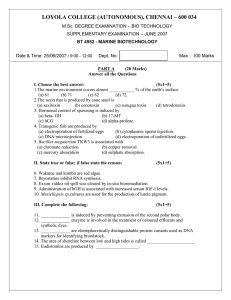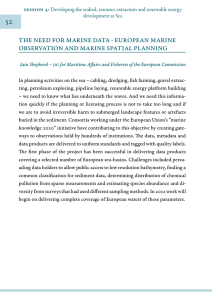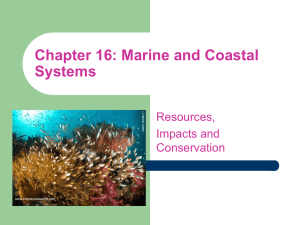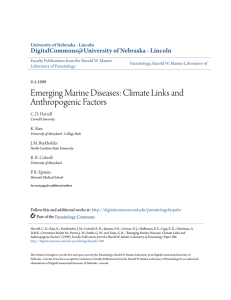LOYOLA COLLEGE (AUTONOMOUS), CHENNAI – 600 034
advertisement
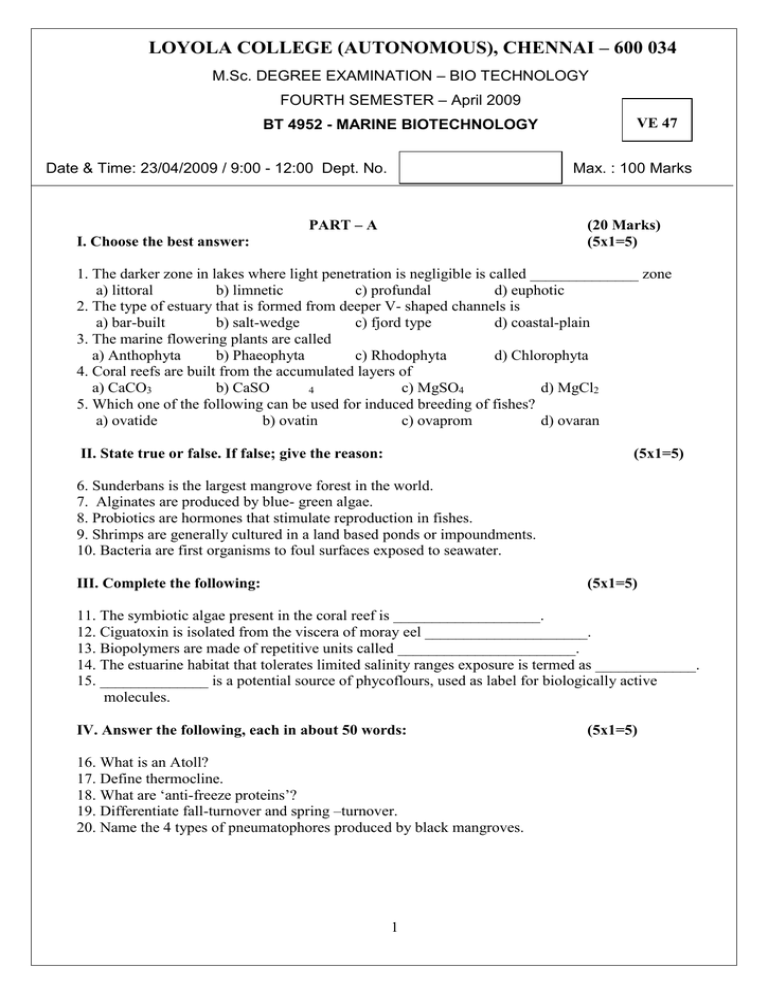
LOYOLA COLLEGE (AUTONOMOUS), CHENNAI – 600 034 M.Sc. DEGREE EXAMINATION – BIO TECHNOLOGY FOURTH SEMESTER – April 2009 BT 4952 - MARINE BIOTECHNOLOGY Date & Time: 23/04/2009 / 9:00 - 12:00 Dept. No. VE 47 Max. : 100 Marks PART – A (20 Marks) (5x1=5) I. Choose the best answer: 1. The darker zone in lakes where light penetration is negligible is called ______________ zone a) littoral b) limnetic c) profundal d) euphotic 2. The type of estuary that is formed from deeper V- shaped channels is a) bar-built b) salt-wedge c) fjord type d) coastal-plain 3. The marine flowering plants are called a) Anthophyta b) Phaeophyta c) Rhodophyta d) Chlorophyta 4. Coral reefs are built from the accumulated layers of a) CaCO3 b) CaSO c) MgSO4 d) MgCl2 4 5. Which one of the following can be used for induced breeding of fishes? a) ovatide b) ovatin c) ovaprom d) ovaran II. State true or false. If false; give the reason: (5x1=5) 6. Sunderbans is the largest mangrove forest in the world. 7. Alginates are produced by blue- green algae. 8. Probiotics are hormones that stimulate reproduction in fishes. 9. Shrimps are generally cultured in a land based ponds or impoundments. 10. Bacteria are first organisms to foul surfaces exposed to seawater. III. Complete the following: (5x1=5) 11. The symbiotic algae present in the coral reef is ___________________. 12. Ciguatoxin is isolated from the viscera of moray eel _____________________. 13. Biopolymers are made of repetitive units called _______________________. 14. The estuarine habitat that tolerates limited salinity ranges exposure is termed as _____________. 15. ______________ is a potential source of phycoflours, used as label for biologically active molecules. IV. Answer the following, each in about 50 words: 16. What is an Atoll? 17. Define thermocline. 18. What are ‘anti-freeze proteins’? 19. Differentiate fall-turnover and spring –turnover. 20. Name the 4 types of pneumatophores produced by black mangroves. 1 (5x1=5) PART -B V. Answer any five of the following questions each in about 350 words: (5x8=40) 21. List the characteristic zonation of standing- water ecosystem. 22. Bring out the salient features of marine toxins naturally contaminating the sea. 23. How metals are recovered by microbes in the marine environment? 24. Explain the significance of hatchery feed and farming practices in shrimp aquaculture. 25. Discuss the salient features of an estuarine ecosystem. 26. Explain the role of marine microbes in pollution abatement. 27. Discuss briefly the commercial importance of marine natural products and their pharmaceutical applications. 28. What are the various applications of PCR in aquaculture? PART -C VI. Answer the following questions each in about 1500 words: (2 x 20 = 40) 29. (a) Comment on the emerging trends in marine agronomy that exploits seaweed cultivation for a variety of consumer products. (or) (b) Illustrate the marine biofouling process and add a note on its control. 30. (a) Describe the three stages of coral reef development around a new volcanic island. (or) (b) Discuss the genetic & hormonal manipulation of reproduction in fishes. *************** 2

